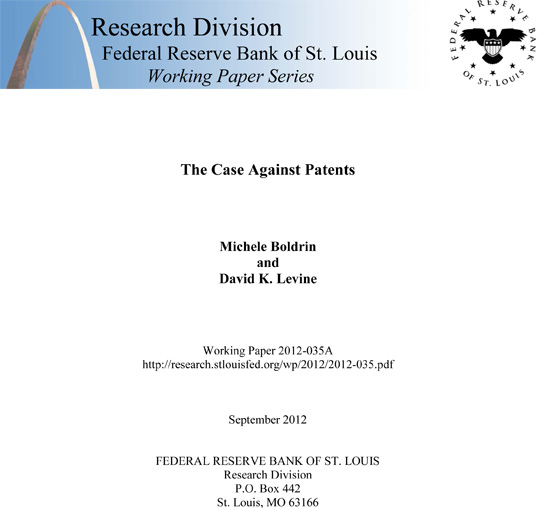Thanks to colleagues in France with whom I exchange on the French innovation system, I was given the opportunity to know more about Michele Boldrin and David K. Levine.
Their Case Against Patents (full pdf here) is a strange work given its extreme position. I do believe it is worth reading this 25-page document but if you are too in a hurry, here are some excerpts with my comments in italics. I have already mentioned my concerns about IP in Is Intellectual Property out of Breath? or Patents inhibit innovation, let’s delete them! (though I was not the author of this title!) or finally Is there something rotten in the kingdom of VC?. So you see the topic is not new to me.

[Page 1] There is no empirical evidence that they serve to increase innovation and productivity […] there is strong evidence, instead, that patents have many negative consequences.
[Page 2] There is little doubt that providing a monopoly as a reward for innovation increases the incentive to innovate. There is equally little doubt that granting a monopoly for any reason has the many ill consequences we associate with monopoly power – the most important and overlooked of which is the strong incentive of a government granted monopolist to engage in further political rent-seeking to preserve and expand his monopoly or, for those who do not yet have it, to try obtaining one.
About the Diffusion of Innovation [pages 2-3]
A second widely cited benefit of patent systems – although not so much in the economics literature – is the notion that patents are a substitute for socially costly trade secrecy and improve communication about ideas. […] More to the point, companies typically instruct their engineers developing products to avoid studying existing patents so as to be spared subsequent claims of willful infringement.
This I can confirm with the following answer I got once, when trying to licence IP for firm XXX: “The XXX lawyers advise the XXX employees not to read patent applications or patents from non-employees because that might preclude the XXX employees from future invitations in that area. If you are interested in selling the intellectual property, the only time XXX has ever bought IP is when there was already a start-up trying to market that IP.”
About Pharma [pages 4-5]
Generally the fixed cost of producing software is low – although it is estimated that Apple spent 150 million USD developing the iPhone. This, however, pales in comparison to the cost of developing new medicines – which is estimated to have a present value of closer to 1 billion USD – the same way it does in front of that for developing a new model of automobile, which is in the same range. Interestingly it is also true that – according to both survey and anecdotal evidence – patents play an important role in encouraging innovation in the pharmaceutical industry while playing a minor one in that of cars, insofar as new components and even plants are often developed by consortia or joint-ventures of otherwise fiercely competitive producers marketing different automobile’s brands. The relevance of patents in the pharmaceutical industry is most likely not due to the high fixed costs but rather the fact that disclosure in the case of drugs is more meaningful than in that of cars and most other products [Semiconductor is another good example similar to automobile]. The chemical formula and the efficacy of the cure as established by clinical trials are available to competitors essentially for free and it is the second (a public good, privately produced due to a political choice) that accounts for about 80% of the initial fixed cost. […] Hence various economists, holding differing views about intellectual property, have nevertheless argued that if government intervention is indeed needed in this market a system of prizes would be far superior to the existing system of monopolies.
About IP and Mature Innovations [page 5]
As the industry matures, demand stabilizes and becomes much less elastic; the scope for cost-reducing innovations decreases, the benefits of monopoly power grow and the potential for additional product innovation also shrinks. Typically there is a “shake-out” in which many firms either leave the industry or are bought out. The automobile industry is a classical historical example but the much more recent “bursting” of the dotcom “bubble” is, in fact, one we may recall better and that makes this point even more forcefully. At this stage rent-seeking does become important and patents are widely used to inhibit innovation, prevent entry, and encourage exit.
[Page 11] Nor, apparently, most industrial organization researchers, seem interested in figuring out why patents are either ignored or scarcely used in new and competitive industries while being highly valued and over-used in mature and highly concentrated ones.
[Page 20] In new industries such as biotechnology and software where innovation was thriving in the absence of patents – patents have been introduced. Given this continued extension has there been a substantial increase in innovation in recent years? On the contrary, it is apparent that the recent explosion of patents in the U.S., the E.U. and Japan, has not brought about anything comparable in terms of useful innovations and aggregate productivity.
I add here that neither the microprocesseur, nor the Internet were ever patented; when the internet was finally opened to commercial applications or when the patent on the transistor was licensed to many players in the 50s (which is quite close to putting it in the public domain), then new innovations multiplied.
About Patent Trolls and NPEs (Non Practicing Entities) [page 8]
Despite the fact that patents are mostly used for arms races and that these, in turn, are driven by patent trolls, there are not formal models of the way in which this can inefficiently inhibit entry. In the arms race theory, if all firms get counterbalancing patent portfolios and all innovate, then they would have innovated in the absence of patents – hence patents do not serve to encourage innovation. On the other hand if (like Microsoft or other patent trolls) you do not produce a marketable product you cannot be countersued, and so you can use patents to share the profits without doing the work – hence patents do discourage innovation and are a pure waste from a social standpoint.
The Patent System is Broken, But can it be Fixed? [Pages 9-10]
There is little dispute among economists that a well-designed patent system would serve to encourage innovation. There is dispute among economists about whether the patent system as it exists serves to encourage innovation – but, again, there is little dispute among economists that the patent system as it exists is broken.[…] If a well-designed patent system would serve the intended purpose, why recommend abolishing it? Why not, instead, reform it? To answer the question we need to investigate the political economy of patents: why has the political system resulted in the patent system we have? Our argument is that it cannot be otherwise. […] On the one hand we find the traditional advocacy of ideal patents as designed by a benevolent planner and, on the other hand, the recognition that patent laws are mostly designed by interest groups keen to increase their monopoly rents, not aggregate welfare.
No Incentive for Reform [page 12]
The basic public choice observation recalled earlier implies that there are many players in the patent game but that “consumers” are not among them. On the side of the potential patentees there are individual inventors, corporate inventors and patent trolls who invent nothing but never-the-less fill out patent applications making claims. On the other side is the patent office that issues patents, the patent lawyers who file and litigate patents, and the courts where the litigation takes place. The rules of the game are established – although only in part – by the executive and legislative branches of government, and insofar as the interests of the general public are concerned, it is these players who represent them. Since patenting is a technical subject about which few voters know anything with clarity – and hardly any are likely to have a detailed empirical knowledge of the consequences of patent systems – the interests of voters are not well represented at all, but rather the competing interests of the other players. […]It should be clear, then, that given this set of players and their incentives, the patent game can have only one equilibrium over time, which is the one we have observed. […]At each stage of this process of enlargement the main driving force were the rent-seeking efforts of large, cash rich companies unable to keep up with new and creative competitors. Patent lawyers, patent officials and wannabe patent trolls usually acted as foot soldiers.
Abolishing Patents[page 20]
Abolishing patents may seem “pie-in-the-sky” and there are certainly many interim measures that can be taken to mitigate the damage: properly interpreting obviousness, requiring genuine disclosure of working methods and an independent invention defense against patent infringement are useful and – among economists – relatively uncontroversial measures. But why use a band-aid to staunch a major wound? Economists fought for decades – and ultimately with great success – to abolish trade restrictions. It will not escape the careful reader that patents are very much akin to trade restrictions as they prevent the free entry of competitors in national markets, thereby reducing the growth of productive capacity and slowing down economic growth. The same way that trade restrictions were progressively reduced until reaching (almost complete) abolition, a similar (albeit, hopefully less slow) approach should be adopted to “get rid” of patents. Moreover the nature of patents as time-limited makes it relatively easy to phase them out by phasing in ever shorter patent durations. This conservative approach has also the advantage that if reducing patent terms indeed has a catastrophic effect on innovation the process can easily be reversed.
[…]
Patents should be allowed only when monopoly power is justified by evidence about fixed costs and actual lack of appropriability.
[…]
The results of federally subsidized research cannot lead to the creation of new private monopolies but should be available to all market participants. This reform would be particularly useful for the pharmaceutical industry.
I have not read (yet) their Against Intellectual Monopoly but I should given the depth of their thought. As they themselves claim, this may all be “pie in the sky”, irrealistic and therefore useless, and I also see the Libertarianism behind all this. But once again, I believe it is worth thinking about it twice, and longer than just reading this long summary.


